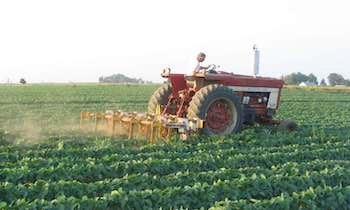
~ Press release issued by the Virginia Farm Bureau Federation
PAMPLIN — An early-October frost and general lack of autumn rainfall created a window for Virginia soybean farmers to harvest their crop weeks ahead of wetter years.
The National Agricultural Statistics Service’s Virginia Field Office reported that most Virginia locations had zero precipitation in past weeks.
“There are abnormally dry to moderate drought conditions in the state,” said Herman Ellison, NASS state statistician for Virginia.
Soybean harvests are 59 percent completed, compared to 47 percent at this time last year.
Charlotte County soybean and wheat grower Henry Carwile said he’s already harvested 120 acres of soybeans grown at Ridgefork Farm.
“We usually do a lot of threshing in October and finish up between the middle of November to Thanksgiving,” he said. “So we’re finished a little bit early this year. We had that real early frost too, which helped these late double-crop beans to dry down quicker.”
Joanne Jones, a Virginia Cooperative Extension agent in Charlotte County, has spoken with other soybean farmers who also enjoyed an early harvest.
Soybeans are sensitive to environmental moisture, and drier conditions can help combat crop loss.
“In this area, we went the whole month of October with only one rainy day,” Jones said. “With a long rainy spell, mold or fungus can grow on the beans while still in the pod and cause damage.”
Research shows that early planting results in earlier harvest and is critical to producing high soybean yields, which is what many full-season crop producers are doing, Jones added.
Double-crop farmers like Carwile now are taking advantage of the dry spell to finish winter wheat planting. “Double cropping” refers to the harvesting of two crops off the same land in one calendar year, such as winter wheat in the spring and soybeans in the fall.
While double-cropping can result in smaller yields, having two harvests reduces the risk of total crop loss, said Robert Harper, grain marketing specialist for Virginia Farm Bureau Federation.
“This way farmers are not putting all their eggs in one basket,” he said.
Soybeans in the field will continue to grow until stalled by the next frost, Harper added.
“Frost might take the top off the yield but will help full-season beans dry down better,” he said. “But we’re way ahead on harvest this year because of the dry weather!”
Many Virginia soybeans are exported to Asian countries, and others are used in food for humans and animals and in industrial and consumer products, including building materials, cooking oil and crayons.
•••
RELATED ARTICLES
Gov. Youngkin awards grant for meat processing study in Fauquier County
It’s a sweet season for Virginia apples
Turkey prices double as Thanksgiving approaches
Virginia farmers growing fragrant lavender to diversify
Record funding allows farmers to implement conservation projects for FREE
New budget gives Virginia’s farmers record funding for soil and water conservation
Incentive payment rates increase for poultry litter transport



Be the first to comment